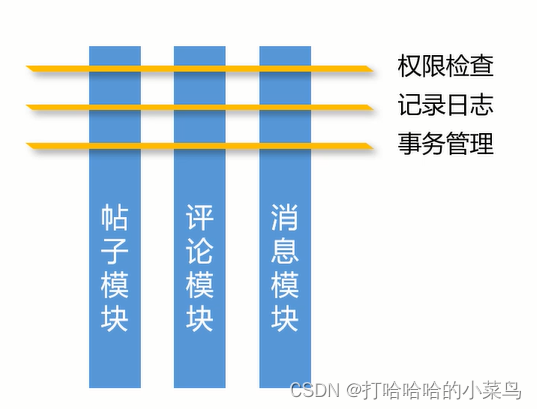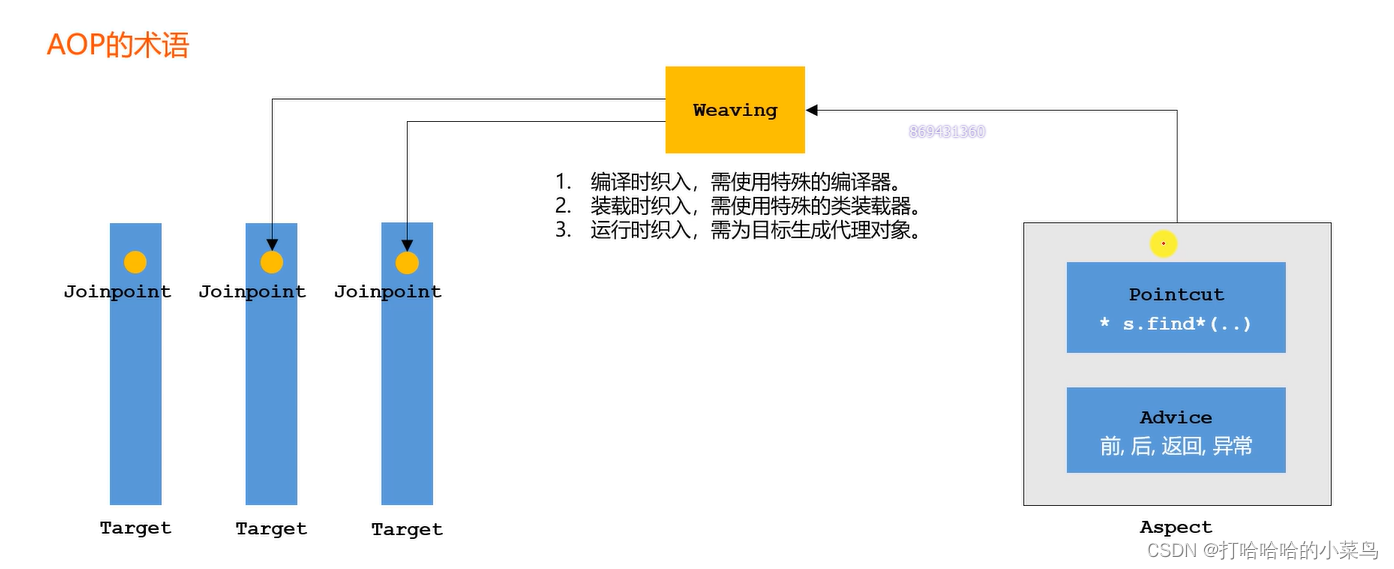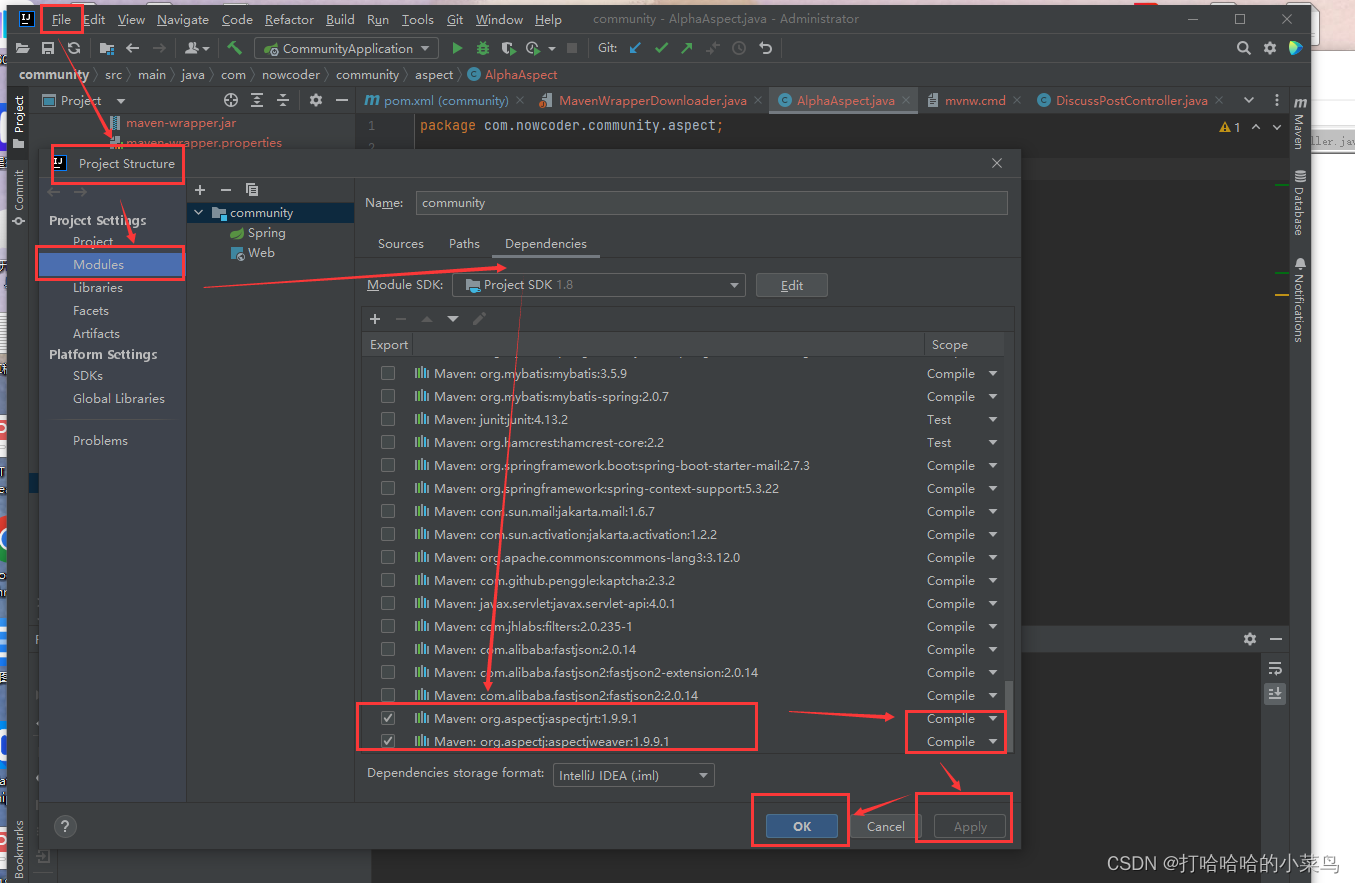-
3-10:统一记录日志
对所有的业务记录日志;注意日志与业务的耦合问题
AOP的概念
Aspect Oriented Programing,即面向方面(切面)编程。
- AOP是一种编程思想,是对OOP的补充,可以进一步提高编程的效率。


targert: 业务组件是需要处理的目标,目标对象;程序中已经开发好的bean
aspect: 封装业务需求的方面组件;编程的过程针对于aspect;
织入:将方面组件的代码,织入到目标对象;分为不同的时机,
Joinpoint:连接点,在业务组件的哪个位置织入对象 - 织入时越原始,运行速度越快;
- 织入早,特殊情况处理的不精细;
- 织入晚,处理各种情况灵活,但运行速度慢。
Aspect中需要完成的任务
- 声明Pointcut
声明切点,用表达式来声明,具体要把代码织入到那些目标对象的那些位置 - Advice通知
实现具体的系统逻辑,织入到成员方法的前,后,返回,异常处等等。
AOP的实现
列举两项,实际实现方式还有很多
AspectJ
- AspectJ是语言级的实现,它扩展了Java语言,定义了AOP语法。(新的语言,功能强大,但学习代价高)
- AspectJ在编译期织入代码,它有一个专门的编译器, 用来生成遵守Java字节码规范的class文件。
Spring AOP
- Spring AOP使用纯Java实现,它不需要专门的编译过程,也不需要特殊的类装载器。(方便上手)
- Spring AOP在运行时通过代理的方式织入代码,只支持方法类型的连接点。(80%以上的项目,都是织入到方法里。灵活)
- Spring支持对AspectJ的集成。(高的性价比,有效)
代理方式
Spring AOP
-
JDK动态代理
- Java提供的动态代理技术,可以在运行时创建接口的代理实例(织入代码到代理对象里)。(目标对象需要有接口)
- Spring AOP默认采用此种方式,在接口的代理实例中织入代码。
-
CGLib动态代理
- 采用底层的字节码技术,在运行时创建子类代理实例。
- 当目标对象不存在接口时,Spring AOP会采用此种方式,在子类实例中织入代码。
实现实例
- 创建aspect包
- 创建相关业务aspect类
在添加@Aspect 注解时,出现了一个错误,相关的import org.aspectj.lang.annotation相关的全部标红;经过查询多方面的资料
在正确将依赖添加后,按如图所示操作即可

AlphaAspect.java
package com.nowcoder.community.aspect; import org.aspectj.lang.ProceedingJoinPoint; import org.aspectj.lang.annotation.*; import org.springframework.stereotype.Component; @Component //声明一个bean用容器去管理 @Aspect //定义这是一个切片aspect bean public class AlphaAspect {//针对所有的service对象,而不用修改service @Pointcut("execution(* com.nowcoder.community.service.*.*(..))")//定义切点,描述那些bean和方法,是要处理的目标 public void pointcut() { } //定义连接点实现的具体方式 //连接点开头时织入代码 @Before("pointcut()") public void before() { System.out.println("before"); } //连接点之后时织入代码 @After("pointcut()") public void after() { System.out.println("after"); } //有了返回值以后,处理一些逻辑 @AfterReturning("pointcut()") public void afterRetuning() { System.out.println("afterRetuning"); } //在抛异常后的时候织入代码 @AfterThrowing("pointcut()") public void afterThrowing() { System.out.println("afterThrowing"); } //连接点前后都织入逻辑,需要有返回值 @Around("pointcut()") public Object around(ProceedingJoinPoint joinPoint) throws Throwable { System.out.println("around before"); Object obj = joinPoint.proceed();//调(原始)目标组件的方法,被织入到代理对象 System.out.println("around after"); return obj; } }- 1
- 2
- 3
- 4
- 5
- 6
- 7
- 8
- 9
- 10
- 11
- 12
- 13
- 14
- 15
- 16
- 17
- 18
- 19
- 20
- 21
- 22
- 23
- 24
- 25
- 26
- 27
- 28
- 29
- 30
- 31
- 32
- 33
- 34
- 35
- 36
- 37
- 38
- 39
- 40
- 41
- 42
- 43
- 44
- 45
- 46
- 47
- 48
- 49
- 50
处理正式的逻辑,记录日志(用户以ip地址表示)
ServiceLogAspect.javapackage com.nowcoder.community.aspect; import org.aspectj.lang.JoinPoint; import org.aspectj.lang.annotation.Aspect; import org.aspectj.lang.annotation.Before; import org.aspectj.lang.annotation.Pointcut; import org.slf4j.Logger; import org.slf4j.LoggerFactory; import org.springframework.stereotype.Component; import org.springframework.web.context.request.RequestContextHolder; import org.springframework.web.context.request.ServletRequestAttributes; import javax.servlet.http.HttpServletRequest; import java.text.SimpleDateFormat; import java.util.Date; @Component @Aspect public class ServiceLogAspect { private static final Logger logger = LoggerFactory.getLogger(ServiceLogAspect.class); @Pointcut("execution(* com.nowcoder.community.service.*.*(..))") public void pointcut() { } @Before("pointcut()")//前置通知,在开头织入 public void before(JoinPoint joinPoint) { // 用户[1.2.3.4],在[xxx],访问了[com.nowcoder.community.service.xxx()]. ServletRequestAttributes attributes = (ServletRequestAttributes) RequestContextHolder.getRequestAttributes();//获取用户ip,强制类型转换,转换为子类型,宏能多一点 HttpServletRequest request = attributes.getRequest(); String ip = request.getRemoteHost();//获取用户ip String now = new SimpleDateFormat("yyyy-MM-dd HH:mm:ss").format(new Date());//时间,指定格式 String target = joinPoint.getSignature().getDeclaringTypeName() + "." + joinPoint.getSignature().getName();//目标的类名和方法名 //那个类(joinPoint.getSignature().getDeclaringTypeName() )那个(joinPoint.getSignature().getName())方法 logger.info(String.format("用户[%s],在[%s],访问了[%s].", ip, now, target));//写入日志 } }- 1
- 2
- 3
- 4
- 5
- 6
- 7
- 8
- 9
- 10
- 11
- 12
- 13
- 14
- 15
- 16
- 17
- 18
- 19
- 20
- 21
- 22
- 23
- 24
- 25
- 26
- 27
- 28
- 29
- 30
- 31
- 32
- 33
- 34
- 35
- 36
- 37
- 38
- 39
- 40
- 41
重启项目验证即可!
- AOP是一种编程思想,是对OOP的补充,可以进一步提高编程的效率。
-
相关阅读:
Django的runserver部署和uwsgi部署对比
「MySQL高级篇」MySQL之MVCC实现原理&&事务隔离级别的实现
赋安消防主机FS5050,波特率20k,单模单芯SC接头,9-36V直流供电的光纤联网方式之一
C++ 4种智能指针的定义与使用——学习记录008
[ROS]在VS Code下编写代码,汇总问题及解决办法
【稳定性】揭秘团队快速排查问题的三字经,你学会了吗?
案例-JS控制二级联动
突破“三个九”!离子阱量子计算再创新高
python安装介绍
Mac vsCode快捷键总结
- 原文地址:https://blog.csdn.net/qq_41026725/article/details/127731280
